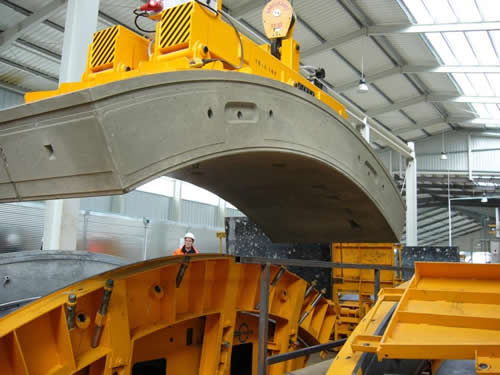Manufacturing: a true story
By Mike Sullivan
MANUFACTURING as we know it doomed in Australia? Only a matter of time before ‘manufacturing’ moves offshore? You would think it, if your sources of information are mainstream media.
The noise over the demise of the car manufacturing sector in Australia – with Ford, General Motors Holden and Toyota announcing in quick succession that their Australian vehicle assembly plants would all close around 2017 – may have abated, but there remain whispers that his may actually become Australian manufacturing’s greatest opportunity.
 Many of those whispers are about how the government support that propped up the auto manufacturing industry in its ailing years should be redirected to catalyse growth in new sectors where Australian companies have an edge.
Many of those whispers are about how the government support that propped up the auto manufacturing industry in its ailing years should be redirected to catalyse growth in new sectors where Australian companies have an edge.
The auto companies themselves have become part of that process, with Ford Australia the first to contribute millions of dollars to programs that assist new and growing manufacturers across a range of industries including food, construction, aerospace and sports design-manufacture, in Victoria.
Ford, after all, may be moving away from making cars here, but it is also spending a lot of money on its design and prototyping facility that will remain at Broadmeadows and focus on projects for Ford globally. Ford Australia is, in fact, moving up the global automotive food chain.
So is General Motors Holden, pumping up its own design facility at Fisherman’s Bend to also take on vital design work for its global parent.
Technology diffusion organisation QMI Solutions chief executive, Gary Christian, said the situation was still very fluid but he believes this is a time of opportunity for Australian manufacturing to re-set and then thrive. He refers to “advancing manufacturing” rather than advanced manufacturing and he sees design-led manufacturing as a key to its future here.
“Is it advanced manufacturing or is it ‘advancing’ manufacturing?” Mr Christian asked. “I think we are advancing it to the next level.”
CSIRO business development and commercial director, Peter Kambouris is on the same wavelength.
“The demise of the automotive industry has had quite a profound effect,” Mr Kambouris said. “But I am actually enthusiastic around the response of the other sectors.
“Look at the minerals and resources sectors – they are driving a lot of our manufacturing anyway, but are below the noise level. Look at the medical devices sector. Look at the specialty equipment guys. 
“Take, for example, Rode microphone, down in Melbourne. They are the leading microphone manufacturer – I personally think – globally. We have a company here called Sutton Tools. They make drill bits. They have been making them since 1917. They are doing something right.
“Look at a local company here (in Brisbane) named Ferra Engineering. Again, they diversified out of automotive a long time ago and they are making the most of their knowledge around manufacturing, managing global supply chains, they have got an export focus, keeping up the technology.” Among other things, Ferra also makes components for the Lockheed F-35 Joint Strike Fighter and has set up a US manufacturing arm.
Stephen Goh, an Engineers Australia national councillor and senior lecturer in mechanical engineering at the University of Southern Queensland, has plenty of first-hand experience with local manufacturers thriving because of they have “innovation in their DNA”.
“One of the companies we are working with at the moment is designing tractors and building tractors in a little town called Toowoomba, of all places,” Dr Goh said. “I can see that the company has high aspirations and they want to be moving towards exporting.
“Some of these tractors have very high tech equipment, some of them remote sensing equipment, control equipment, GPS enabled. They also have machine vision equipment on there as well, to know when the tractor is doing the harvesting, they are actually sensing what is happening with the soil, with the weeds and sensing that and actually destroying he weeds as they go by very precisely killing those weeds. So, amazing advances.
“You can always import tractors from America, or from China, but they don’t have this ability. This is 21st century thinking.”
Dr Goh said Australian manufacturing had to focus on areas in which it had a discernible lead – and then extend that lead. He has been working with several companies in the construction industry, helping them to design and build hi-tech, economical and environmentally sound fast-build homes – where research shows there is massive worldwide demand. Australia has a lead in this area from working in modeular homes and fast-build mining communities.
“In the modular and fabricated housing sector,” Dr Goh said Australia had an existing edge. “This is a fairly cottage based industry currently and we are looking to progress. 
“Construction is still using fairly traditional methods and it is like building inside a ship – it is just a big ship – and I think (the current industry) is not quite there as it is not using some of the sophisticated tools available in modern manufacturing. I think it is about moving from construction to manufacturing.
“There is technology involved, like using robotics and other things to improve efficiency and lower the cost base,” Dr Goh said. “But also, with regards to streamlining the processes as well.
“I think the whole supply chain needs to be investigated further. There is plenty of opportunity to lift that cottage industry out from where it is at the moment into the 21st century in terms of hi-tech manufacturing.
“My personal thinking is that you’ve got flat pack Ikea furniture – and you can have a flat pack house ready to assemble on site, or literally transported to the site, ready to move in.”
Both Mr Kambouris and Dr Goh mentioned the need for Australian industry to embrace advances in robotics and new materials technologies – with breakthroughs in both these areas being made in Australia at present.
“Another area is agriculture,” Dr Goh said, mentioning the move to agricultural robotics being driven out of Queensland. “The potential there is enormous for the manufacturing industry.”
He said Australia had to stay out of the large volume production mindset and focus on high-quality high-return niches.
“Our cost base does not warrant us to be a global supplier for a fairly commoditised product,” Dr Goh said. “ However, in saying that, Wagners (a multi-industry Darling Downs-based company, known for recently building its own airport at Wellcamp and for materials development, producing composite power poles and bridges) do specialise in niche product. The products no-one wants to design for. Often they are one-off or two-off.
“They might make significant volumes of one or two pieces, but the design aspects are on a one-off basis. Just say a Chinese manufacturer might be able to manufacture a fibre-composite bridge that’s 10m long – and that’s all they can do from that factory. The Wagners say, we can do 10m yes, but we can also do 20m or we can do 50m … we can do 2m wide we can do 5m wide … and so on.
“I think it is about the design ability and the manufacturing capability. I know a lot of manufacturers around the world are catching up, but we are still winning in that space.”
Mr Kambouris said, “I think nanotech and biotech will be enablers to those key companies.
“The ability to be flexible and agile and adjust to the marketplace is where some of the information systems are that we do quite well in: so communication, sensor and sensor network, plus automation and robotics will allow those companies to utilise the technical material innovations with that informational overlap to help them avoid the costs that others keep on absorbing.
“Allow them to have an extended supply chain that they can manage. And when they make that bridge, they make it once, right the first time, so they do not have to make it two or three times,” Mr Kambouris said.
“When you look at the cost of doing business in Australia and compare labour costs, our labour is not that different to what is in Germany or Japan. So there is something else happening.
“I think a way of addressing that is with the right technical solutions and with the right information layer with it, we can make that bridge once and in the right time and have it made and certified and out the door two or three times faster than we would currently do.
“So in a current costing we might say cost it out to a 10-week process,” Mr Kambouris said. “What if we could get it down to five weeks? What if we could get it to two weeks?
“We are not going to change the nanotech or biotech in there, we are just going to change the way we use the information, to make certain we do it once and do it right the first time.”
Mr Kambouris said there were some very prominent rays of sunshine in Australian manufacturing right now, some of which have come about because of official concern over the demise of the auto factories. He said the industry-led manufacturing innovation precincts – such as those for the food industry and advanced manufacturing (META) were good examples, with more to come.
“I like the way that the precincts have been set up, it’s very useful having industry led outcomes,” Mr Kambouris said. “Not commenting on the precincts themselves, I like the way they have been set up with the industry-led partnership that identifies a need for them and then simply outsources or contracts out the R&D action. In the past it has very much been led by, ‘Have I got an idea for you’.
“We still have the ideas but we can frame them to address that key market requirement. It’s either addressing a cost issue or a hidden cost, or providing a new line of business. It just makes sense.”
Dr Goh said while Australian manufacturing had a long way to go, it should also go a very long way.
“The community in general does not know that we have a manufacturing industry outside the automotive sector,” he said. “It’s about selling the good story around what’s out there.
“We have Cook Medical. We have Wagners in Toowooomba, Russell in Toowoomba. We have a number of global companies based in Australia. Many factories are well equipped to produce products that are exported and utilised not just in this country but around the world.
“We are punching above our weight in many respects,” Dr Goh said. “ I think it is about translating many of these types of successes into everyday language and everyone talking about them.
“It’s not just about having an awards night …. It needs to go into the mainstream.”
ends

 How to resolve AdBlock issue?
How to resolve AdBlock issue?